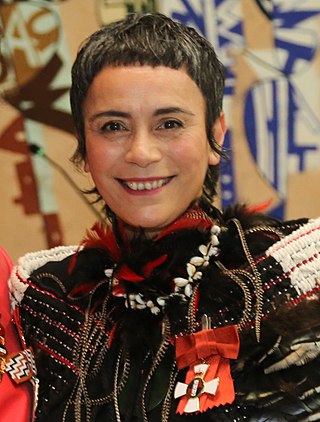Related Research Articles
The Biennale of Sydney is an international festival of contemporary art, held every two years in Sydney, Australia. It is a large and well-attended contemporary visual arts event in the country. Alongside the Venice and São Paulo biennales and Documenta, it is one of the longest running exhibitions of its kind and was the first biennale to be established in the Asia-Pacific region.
Fiona Margaret Hall, AO is an Australian artistic photographer and sculptor. Hall represented Australia in the 56th International Art Exhibition at the Venice Biennale in 2015. She is known as "one of Australia's most consistently innovative contemporary artists." Many of her works explore the "intersection of environment, politics and exploitation".

Shane William Cotton is a New Zealand painter whose work explores biculturalism, colonialism, cultural identity, Māori spirituality, and life and death.

Artspace, officially Artspace Visual Arts Centre, formerly stylised ARTSPACE Visual Arts Centre, is a leading international residency-based contemporary art centre, housed in the historic Gunnery Building in Woolloomooloo, fronting Sydney Harbour in Sydney, Australia. Devoted to the development of certain new ideas and practices in contemporary art and culture, since the early 1980s Artspace has been building a critical context for Australian and international artists, curators and writers.
Michael Te Rakato Parekōwhai is a New Zealand sculptor and a professor at the University of Auckland's Elam School of Fine Arts. He is of Ngāriki Rotoawe and Ngāti Whakarongo descent and his mother is Pākehā.
Yuki Kihara is an interdisciplinary artist of Japanese and Samoan descent. In 2008, her work was the subject of a solo exhibition at the Metropolitan Museum of Art in New York; it was the first time a New Zealander and the first time a Pacific Islander had a solo show at the institution. Titled Shigeyuki Kihara: Living Photographs, the exhibition opened from 7 October 2008 to 1 February 2009. Kihara's self-portrait photographs in the exhibitions included nudes in poses that portrayed colonial images of Polynesian people as sexual objects. Her exhibition was followed by an acquisition of Kihara's work for the museum's collection.

Lucy Orta is an English contemporary visual artist living and working between London and Paris where she has resided since 1991.
Contemporary Indigenous Australian art is the modern art work produced by Indigenous Australians, that is, Aboriginal Australians and Torres Strait Islander people. It is generally regarded as beginning in 1971 with a painting movement that started at Papunya, northwest of Alice Springs, Northern Territory, involving Aboriginal artists such as Clifford Possum Tjapaltjarri and Kaapa Tjampitjinpa, and facilitated by white Australian teacher and art worker Geoffrey Bardon. The movement spawned widespread interest across rural and remote Aboriginal Australia in creating art, while contemporary Indigenous art of a different nature also emerged in urban centres; together they have become central to Australian art. Indigenous art centres have fostered the emergence of the contemporary art movement, and as of 2010 were estimated to represent over 5000 artists, mostly in Australia's north and west.
Ani O'Neill is a New Zealand artist of Cook Island and Irish descent. She has been described by art historian Karen Stevenson as one of the core members of a group of artists of Pasifika descent who brought contemporary Pacific art to "national prominence and international acceptance".
Andrea Daly is a New Zealand jeweller and arts teacher. She studied at Sydney College of the Arts, completing a Bachelor of Visual Arts in 1987. The following year, she gained a Post Graduate Diploma in Visual Arts majoring in contemporary jewellery. In 1998, she completed a Masters in Philosophy majoring in Art History at Auckland University

Lisa Marie Reihana is a New Zealand artist. Her video work, In Pursuit of Venus [Infected] (2015), which examines early encounters between Polynesians and European explorers, was featured at the 2017 Venice Biennale.

Rachael Rakena is a New Zealand artist.
Peter Robinson is a New Zealand artist of Māori descent. He is an associate professor at the Elam School of Fine Arts at the University of Auckland.

Veronica Herber is a New Zealand artist who lives and works in Auckland. She is best known for working with Japanese Washi tape.

Judy Watson is an Australian Waanyi multi-media artist who works in print-making, painting, video and installation. Her work often examines Indigenous Australian histories, and she has received a number of high profile commissions for public spaces.

Brett Graham is a New Zealand sculptor who creates large scale artworks and installations that explore indigenous histories, politics and philosophies.
Megan Lillian Jenkinson is a New Zealand photographer.
Jess Johnson is a New York-based New Zealand contemporary artist who works in drawing, installation, animation, and virtual reality. Her drawings depict alternative realms while her collaborations with Simon Ward and Andrew Clarke adapt the world of her drawings into video animations and virtual reality.

The Australian pavilion houses Australia's national representation during the Venice Biennale arts festivals.
Kulimoe'anga Stone Maka, is an interdisciplinary artist of Tongan heritage who lives in Christchurch, New Zealand. In 2011, he was awarded the Emerging Pasifika Artist Award from Creative New Zealand. Maka's work has been exhibited in museums and art galleries in New Zealand, Hawai'i Australia and Tonga. In 2020 he was selected to represent New Zealand at the 22nd Biennale in Sydney.
References
- ↑ "Ruth Watson". Headlands Center for the Arts. Retrieved 2022-01-28.
- ↑ "CoCA Centre of Contemporary Art Toi Moroki". coca.org.nz. Retrieved 2022-01-28.
- 1 2 "Ruth Watson Biography, Artworks & Exhibitions". ocula.com. 2022-01-28. Retrieved 2022-01-28.
- ↑ "Between light and dark matters : Ruth Watson". ruthwatson.net. Retrieved 2022-01-28.
- ↑ "Redoubting Antarctica". Two Rooms. Retrieved 2022-01-28.
- ↑ "This day a man is | Colin McCahon 100". mccahonhouse.org.nz. Retrieved 2022-01-22.